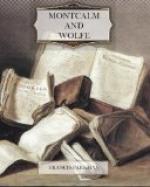Such was the quiet picture painted on the memory of Anne MacVicar, and reproduced by the pen of Mrs. Ann Grant.[320] The patriarchal, semi-rural town had other aspects, not so pleasing. The men were mainly engaged in the fur-trade, sometimes legally with the Five Nations, and sometimes illegally with the Indians of Canada,—an occupation which by no means tends to soften the character. The Albany Dutch traders were a rude, hard race, loving money, and not always scrupulous as to the means of getting it. Coming events, too, were soon to have their effect on this secluded community. Regiments, red and blue, trumpets, drums, banners, artillery trains, and all the din of war transformed its peaceful streets, and brought some attaint to domestic morals hitherto commendable; for during the next five years Albany was to be the principal base of military operations on the continent.
[Footnote 320: Memoirs of an American Lady (Mrs. Schuyler), Chap. VI. A genuine picture of colonial life, and a charming book, though far from being historically trustworthy. Compare the account of Albany in Kalm, II. 102.]
Shirley had left the place, and was now on his way up the Mohawk. His force, much smaller than at first intended, consisted of the New Jersey regiment, which mustered five hundred men, known as the Jersey Blues, and of the fiftieth and fifty-first regiments, called respectively Shirley’s and Pepperell’s. These, though paid by the King and counted as regulars, were in fact raw provincials, just raised in the colonies, and wearing their gay uniforms with an awkward, unaccustomed air. How they gloried in them may be gathered from a letter of Sergeant James Gray, of Pepperell’s, to his brother John: “I have two Holland shirts, found me by the King, and two pair of shoes and two pair of worsted stockings; a good silver-laced hat (the lace I could sell for four dollars); and my clothes is as fine scarlet broadcloth as ever you did see. A sergeant here in the King’s regiment is counted as good as an ensign with you; and one day in every week we must have our hair or wigs powdered."[321] Most of these gorgeous warriors were already on their way to Oswego, their first destination.
[Footnote 321: James Gray to John Gray, 11 July, 1755.]
Shirley followed, embarking at the Dutch village of Schenectady, and ascending the Mohawk with about two hundred of the so-called regulars in bateaux. They passed Fort Johnson, the two villages of the Mohawks, and the Palatine settlement of German Flats; left behind the last trace of civilized man, rowed sixty miles through wilderness, and reached the Great Carrying Place, which divided the waters that flow to the Hudson from those that flow to Lake Ontario. Here now stands the city which the classic zeal of its founders has adorned with the name of Rome. Then all was swamp and forest, traversed by a track that led to Wood Creek,—which is not to be confounded




